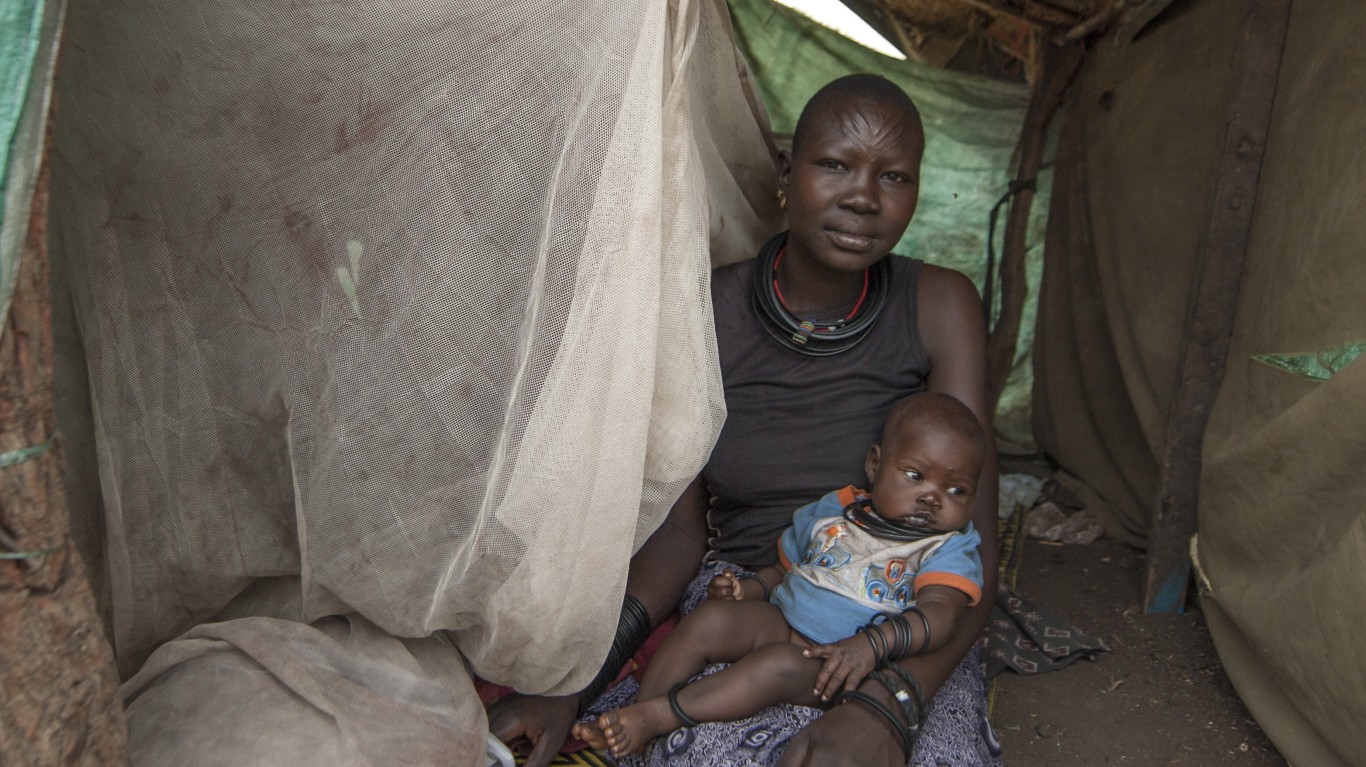
Saudi Arabia has long been criticized globally for its treatment of girls and women. In recent years, reforms, including allowing women to drive cars and easing restrictions on women’s employment among others, have led to measurable improvements. While terms such as “allowing women” are themselves patriarchal and sexist, progress in gender issues in the Islamic kingdom needs to be acknowledged. But Saudi Arabia has actually never been the worst place in the world for girls and women.
Propped up by its vast oil reserves, the country enjoys peace and prosperity while others in the region and elsewhere boil in poverty and conflict – the leading causes of gender-based violence. (Here are 29 countries currently at war.)
To find the 25 worst countries for women, 24/7 Wall St. reviewed the Women, Peace, and Security Index 2021/22 published by Georgetown Institute for Women, Peace and Security and Peace Research Institute Oslo, 2021. Countries are ranked by their index score between 0 and 1, where scores closer to zero denote countries that are worse for women and closer to one better for women. The index ranks 170 countries using 11 indicators, including education, financial and legal bias, gender-based norms, safety, and more. Full methodology can be found in the full report. Population and gross domestic product per capita are from the World Bank.
The eruption of the COVID-19 pandemic in 2020 exacerbated already widening disparities among countries in terms of gender equality, the most recent GIWPS’s report found. “This reflects a worsening of inequalities in the status of women, as countries at the top continue to improve while those at the bottom get worse, mirroring global trends in wealth and income inequality,” Jeni Klugman, managing director of the institute, wrote in the latest WPS Index report, which provides insight into the progress of women’s empowerment across the globe.
Indeed, even an affluent country like the United States, which ranks 21st best among the 170 countries reviewed, has significant disparities between states. The levels of inclusion, justice, and security of women in Massachusetts is four times greater than those for women in Louisiana. Often, these levels mirror wealth, same as across the world’s countries as women in wealthier nations, such as Germany and the United Kingdom, are vastly better off than they are in Sierra Leone or Somalia. (These are the poorest countries in the world.)
Out of the 25 worst countries for women and girls, 17 are in Africa and four are in Central or South Asia. Unsurprisingly, war-ravaged Yemen, Iraq, Syria, and Afghanistan are among the worst countries for women and girls. In 13 of the 25 countries, women spend less than four years in school throughout life, in large part because they tend to marry and give childbirth at a young age. In most of these countries, fewer than one in five women have their own bank accounts.
Here are the worst countries for women.
Click here to see our detailed methodology.

25. Eswatini
> Women Peace and Security Index (0 worst to 1 best): 0.602
> Women’s mean years of education: 6.3, #51 worst of 170 countries
> Pct. of women w/bank account: 27.4%, #31 worst of 170 countries
> Absence of legal discrimination (0 worst to 100 best): 46.3 – #12 worst of 170 countries
> GDP per capita, 2021: $3,978, #69 lowest of 170 countries
> Population, 2021: 1,192,271 (females: 600,441, 50.4%)
This small landlocked kingdom that borders South Africa and Mozambique is populated mostly by ethnic Swazi. Only about 46% of Eswatini women are employed and about 19% report being victims of domestic violence by an intimate partner. A survey conducted in 2007 found that a third of girls ages 13-17 experienced sexual violence before age 18. Eswatini has the world’s highest rate of HIV. The country was known as Swaziland until 2018 when King Mswati III renamed it to honor its 50th independence anniversary.
[in-text-ad]
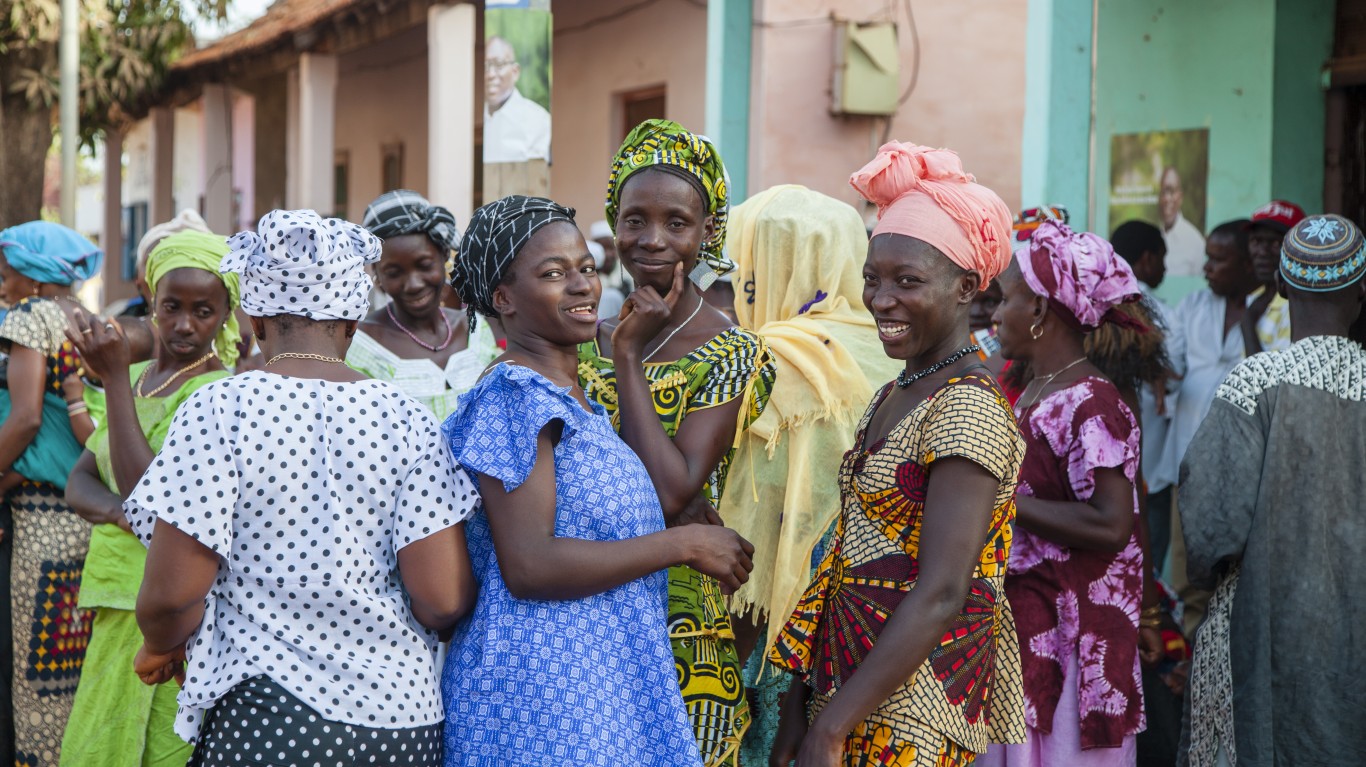
24. Guinea
> Women Peace and Security Index (0 worst to 1 best): 0.602
> Women’s mean years of education: 1.5, #4 worst of 170 countries
> Pct. of women w/bank account: 19.7%, #19 worst of 170 countries
> Absence of legal discrimination (0 worst to 100 best): 76.3 – #65 worst of 170 countries
> GDP per capita, 2021: $1,189, #30 lowest of 170 countries
> Population, 2021: 13,531,906 (females: 6,846,006, 50.6%)
Women in Guinea have some of the lowest education levels in the world at just 1.5 years. About one in five women in this West African country have been subject to domestic violence from intimate partners. The gender rights organization U.N. Women reported that in 2018 about same share of Guinean girls and women ages 15-49 reported they had been subject to physical or sexual violence from a former intimate partner in the previous 12 months. A Guinean court is currently hearing a landmark trial of crimes committed during a 2009 stadium massacre that included security forces raping more than 100 women in retaliation.
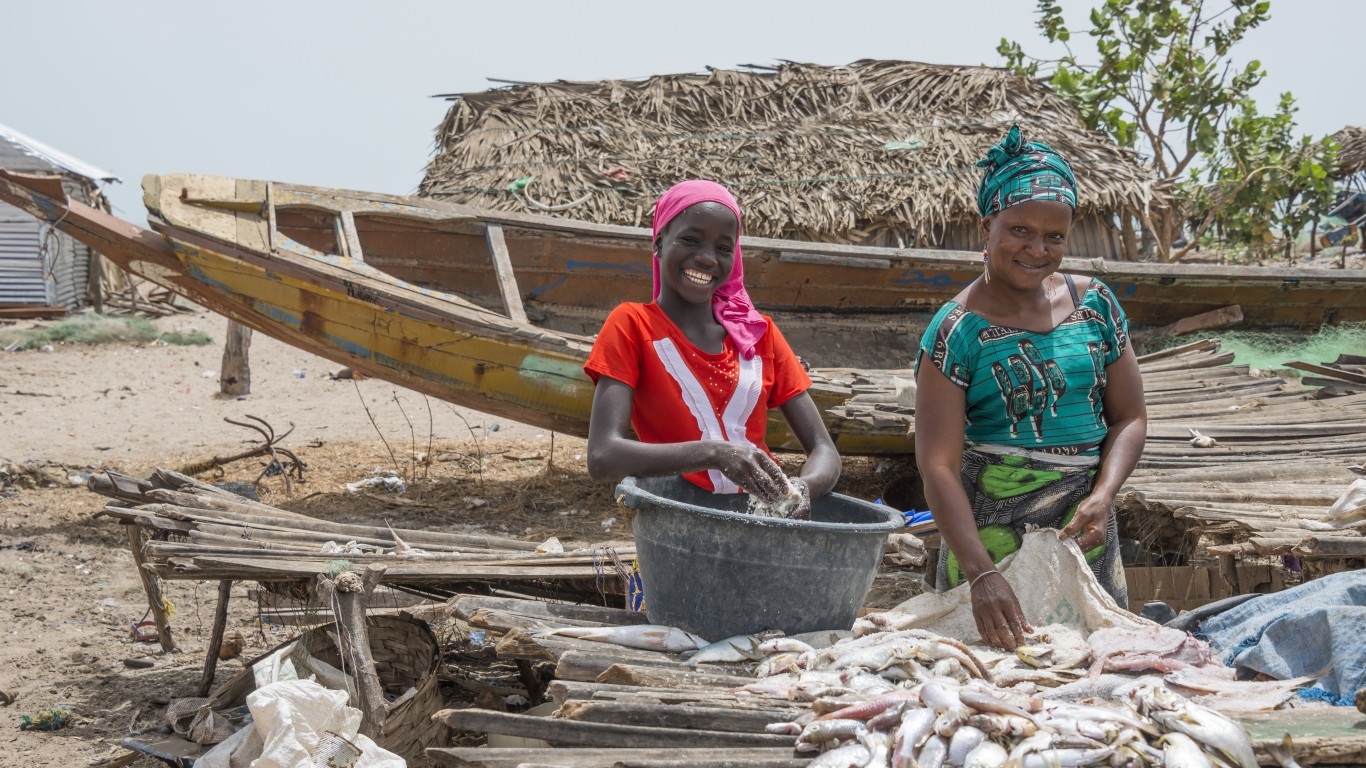
23. Gambia
> Women Peace and Security Index (0 worst to 1 best): 0.597
> Women’s mean years of education: 3.3, #15 worst of 170 countries
> Pct. of women w/bank account: 27.7%, #32 worst of 170 countries
> Absence of legal discrimination (0 worst to 100 best): 74.4 – #55 worst of 170 countries
> GDP per capita, 2021: $772, #18 lowest of 170 countries
> Population, 2021: 2,639,916 (females: 1,326,796, 50.3%)
Gambian women have among the lowest parliamentary representation in the world. According to the antipoverty group the Borgen Project, less than half of women in this tiny West African country are literate. The organization Girls Not Brides estimates that about one out four Gambian girls marry before they turn 18. With local support for the practice of female genital mutilation, UNICEF reported in 2020 that about half of Gambian girls under age 15 have undergone the procedure.

22. India
> Women Peace and Security Index (0 worst to 1 best): 0.597
> Women’s mean years of education: 5.4, #41 worst of 170 countries
> Pct. of women w/bank account: 76.6%, #124 worst of 170 countries
> Absence of legal discrimination (0 worst to 100 best): 74.4 – #55 worst of 170 countries
> GDP per capita, 2021: $2,257, #48 lowest of 170 countries
> Population, 2021: 1,407,563,842 (females: 681,060,412, 48.4%)
India is by far the largest country to rank so low in gender equality and security. It also has the highest bias against newborn girls among the countries on this list and third highest among the 170 countries reviewed based on sex at birth ratio. India’s male-to-female ratio at birth of 1.10, or 110 boys for every 100 girls, is artificially high due to Indian families conducting aborting female fetuses (the worldwide ratio is 1.07, and it is 1.05 in the U.S.). However, that practice appears to be waning, according to a 2022 Pew Research report, showing that “son bias” is on the decline in India. Other problems persist, however, including high rates of women unemployment and intimate partner violence.
[in-text-ad-2]

21. Libya
> Women Peace and Security Index (0 worst to 1 best): 0.596
> Women’s mean years of education: 8.5, #76 worst of 170 countries
> Pct. of women w/bank account: 59.6%, #95 worst of 170 countries
> Absence of legal discrimination (0 worst to 100 best): 50.0 – #18 worst of 170 countries
> GDP per capita, 2021: $6,357, #94 lowest of 170 countries
> Population, 2021: 6,735,277 (females: 3,325,769, 49.4%)
Conditions for Libyan women have not improved since the 2011 country’s revolution despite women’s active role in the political turnover. “Libyan women still lack basic rights and access to political participation and remain underrepresented in the official institutions of the state,” says the Netherlands-based Gender Concerns International. Following a visit to Libya in December 2022, U.N. Special Rapporteur on violence against women, Reem Alsalem, called on authorities in Libya to do more to fight the “grave levels of violence faced by Libyan women and children,” as well as non-Libyan women and girls, such as African migrants attempting to get to Europe.

20. Djibouti
> Women Peace and Security Index (0 worst to 1 best): 0.595
> Women’s mean years of education: 5.4, #41 worst of 170 countries
> Pct. of women w/bank account: 8.8%, #6 worst of 170 countries
> Absence of legal discrimination (0 worst to 100 best): 68.1 – #41 worst of 170 countries
> GDP per capita, 2021: $3,150, #58 lowest of 170 countries
> Population, 2021: 1,105,557 (females: 556,667, 50.4%)
Though female genital mutilation has technically been illegal since the 1980s in this East African country bordering Eritrea, Ethiopia, and Somalia, it remains a popular traditionwith 78% of women and girls subjected to the practice, according to UNICEF. Only 41% of women in the country have cell phone access, an unusually low rate even among the poorest countries. About 27% of women have been targets of intimate-partner abuse, more than twice the worldwide average.
[in-text-ad]
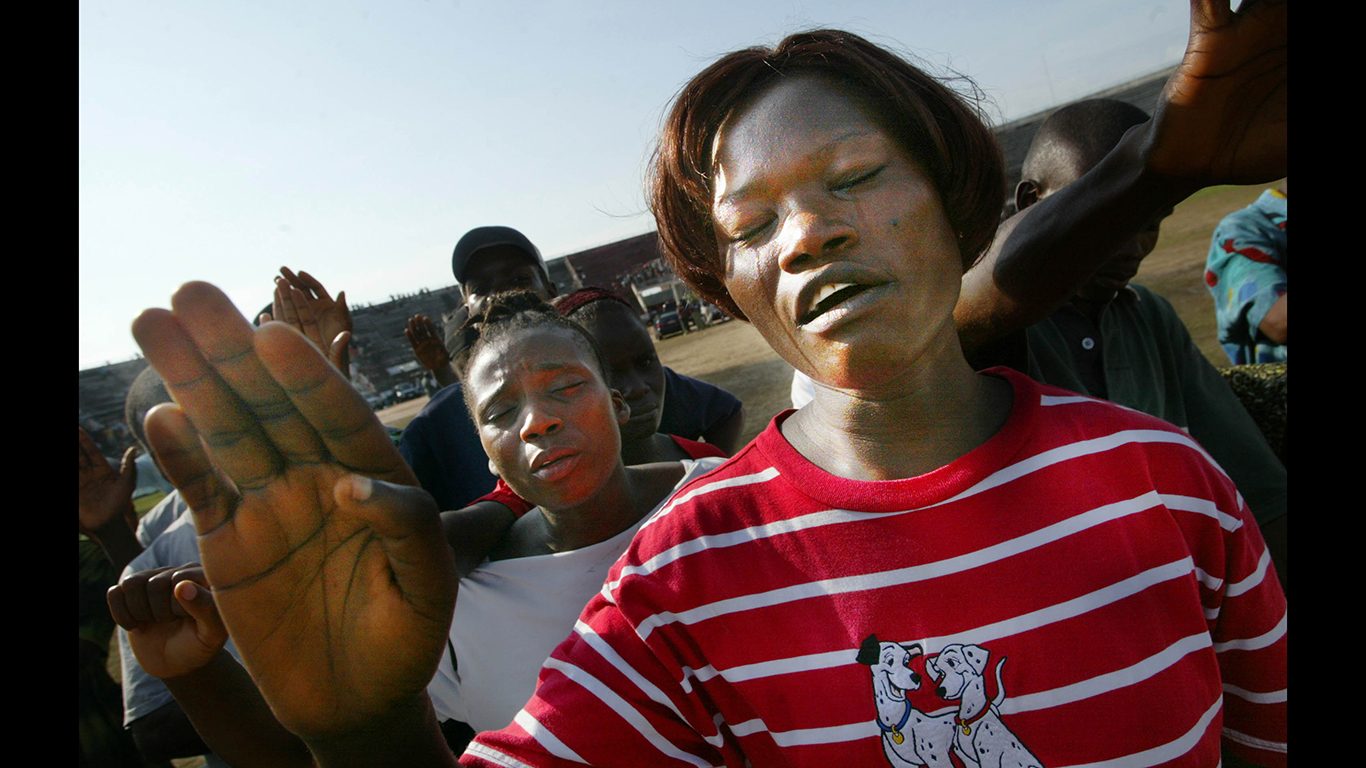
19. Liberia
> Women Peace and Security Index (0 worst to 1 best): 0.594
> Women’s mean years of education: 3.5, #18 worst of 170 countries
> Pct. of women w/bank account: 28.2%, #35 worst of 170 countries
> Absence of legal discrimination (0 worst to 100 best): 83.8 – #105 worst of 170 countries
> GDP per capita, 2021: $676, #14 lowest of 170 countries
> Population, 2021: 5,193,416 (females: 2,608,243, 50.2%)
In 2022, Liberia Amended its nationality law to allow men and women to confer nationality to their children even if one of the parents is not a Liberia citizen. Before the passage of the law, only the children of Liberian men enjoyed “jus soli,” or birthright citizenship. “Gender discrimination in nationality laws remains a primary cause of statelessness among children,” Gillian Triggs, the U.N. Refugee Agency’s assistant high commissioner for Protection, said in a statement responding to Liberia’s reform. The 2021 WPS report estimates more than one out of four Liberian women in the country have reported being abused by an intimate partner, more than double the worldwide average.
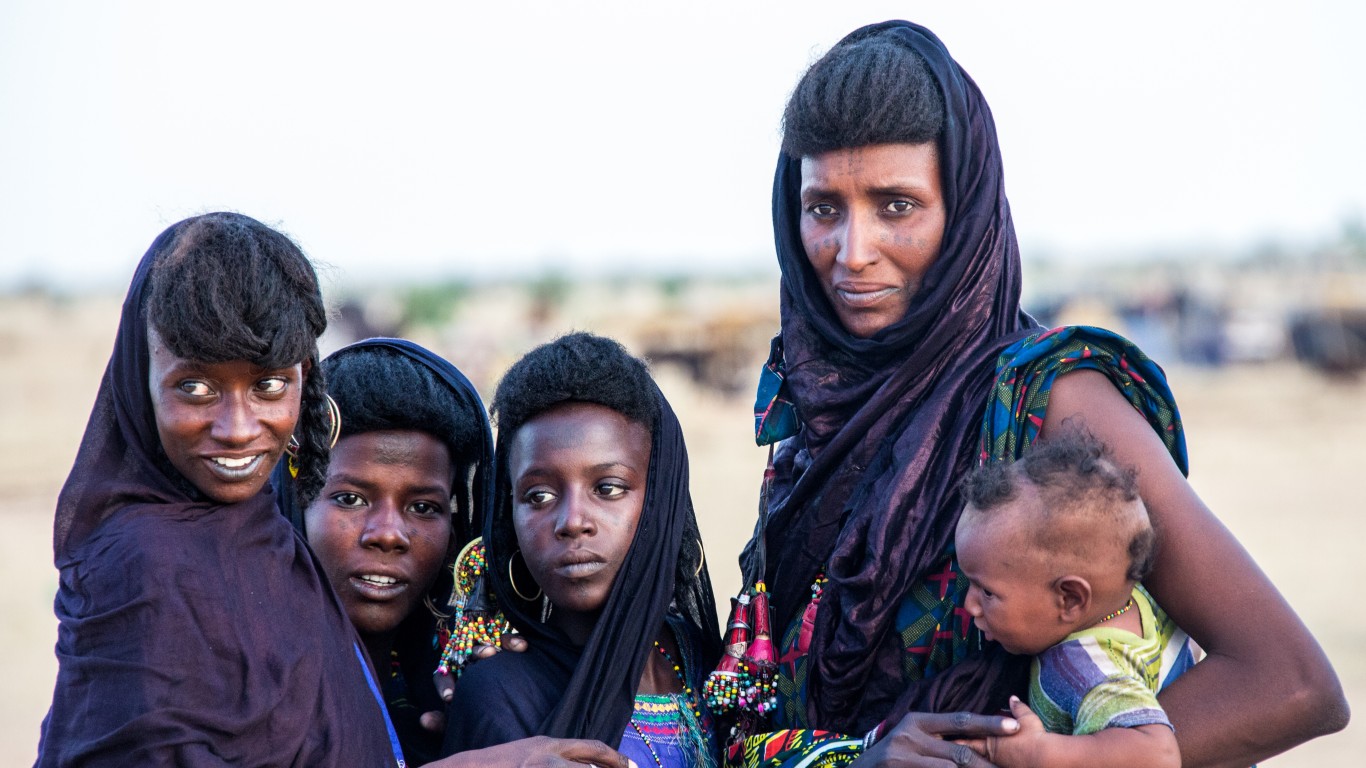
18. Niger
> Women Peace and Security Index (0 worst to 1 best): 0.594
> Women’s mean years of education: 1.4, #3 worst of 170 countries
> Pct. of women w/bank account: 10.9%, #9 worst of 170 countries
> Absence of legal discrimination (0 worst to 100 best): 59.4 – #28 worst of 170 countries
> GDP per capita, 2021: $591, #12 lowest of 170 countries
> Population, 2021: 25,252,722 (females: 12,443,587, 49.3%)
The Niger government implemented in 2019 an order allowing married and/or pregnant girls to continue their studies after giving birth. Unfortunately, according to Human Rights Watch, it is still common to force girls or young women to marry the men who impregnate them even in the cases or rape. The group U.N. Women estimates that 76% of women aged 20-24 in Niger were married before they turned 18. Nigerien women also have unusually low cellphone use, even by the standards of developing countries, at just 44%.
17. Bangladesh
> Women Peace and Security Index (0 worst to 1 best): 0.594
> Women’s mean years of education: 6.0, #46 worst of 170 countries
> Pct. of women w/bank account: 35.8%, #53 worst of 170 countries
> Absence of legal discrimination (0 worst to 100 best): 49.4 – #16 worst of 170 countries
> GDP per capita, 2021: $2,458, #52 lowest of 170 countries
> Population, 2021: 169,356,251 (females: 85,358,163, 50.4%)
Human Rights Watch estimates that nearly 60% of Bangladeshi girls are married before they turn 18, the highest rate in Asia and the fourth-highest globally. The legal definition of rape only covers sexual violence committed by men against women to whom they are not married. Only 35% of women in the country are employed, while nearly one in four have been targets of intimate-partner violence. On a brighter note, a Bangladeshi high court ruled in January 2023 that single mothers are allowed to be the sole guardians of children for school enrollment purposes.
[in-text-ad-2]
16. Republic of the Congo
> Women Peace and Security Index (0 worst to 1 best): 0.582
> Women’s mean years of education: 6.1, #50 worst of 170 countries
> Pct. of women w/bank account: 21.0%, #20 worst of 170 countries
> Absence of legal discrimination (0 worst to 100 best): 49.4 – #16 worst of 170 countries
> GDP per capita, 2021: $2,290, #49 lowest of 170 countries
> Population, 2021: 5,835,806 (females: 2,921,372, 50.1%)
According to the OECD’s Social Institution & Gender Index, laws in the Republic of Congo do not provide women with the same rights as men in marriage, divorce, or inheritance; disproportionately sanctions women for adultery, which is criminalized; and still permit child marriage of girls despite a law against it. About one in three women are subjected to violence from an intimate partner, according to the 2021 WPS Index, the fifth highest rate of the 170 countries reviewed.
15. Madagascar
> Women Peace and Security Index (0 worst to 1 best): 0.578
> Women’s mean years of education: 6.4, #53 worst of 170 countries
> Pct. of women w/bank account: 16.3%, #14 worst of 170 countries
> Absence of legal discrimination (0 worst to 100 best): 74.4 – #55 worst of 170 countries
> GDP per capita, 2021: $501, #9 lowest of 170 countries
> Population, 2021: 28,915,653 (females: 14,424,717, 49.9%)
Some progress on women’s rights has been achieved in Madagascar, with the gender equality group U.N. Women estimating that in 2018 about two out of three women of reproductive age had access to modern family planning methods. However, about 40% of women aged 20-24 were married as girls. Based on the 2021 WPS Index, just 39% of women in Madagascar use cell phones, the fourth lowest share worldwide, while more than a third of them have been targets of intimate partner violence, the third highest share worldwide.
[in-text-ad]
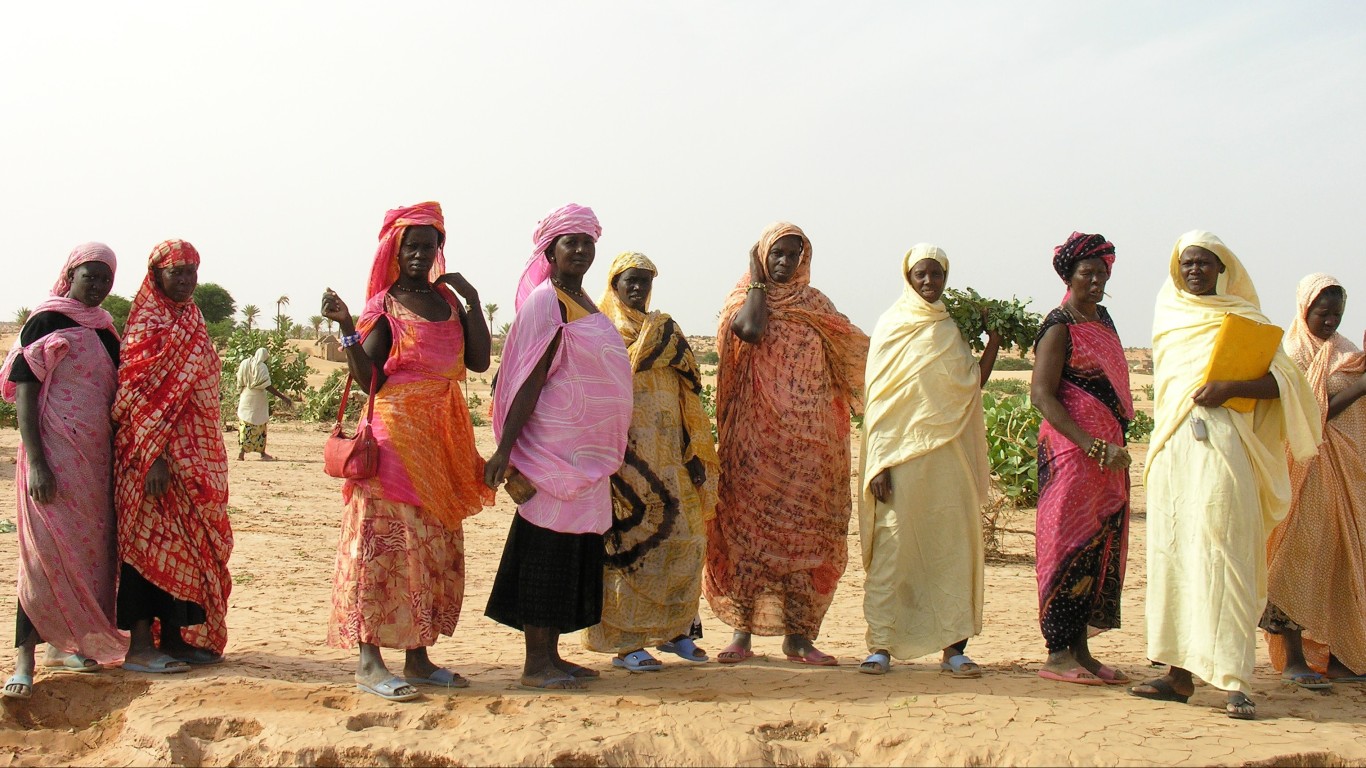
14. Mauritania
> Women Peace and Security Index (0 worst to 1 best): 0.577
> Women’s mean years of education: 3.8, #20 worst of 170 countries
> Pct. of women w/bank account: 15.5%, #12 worst of 170 countries
> Absence of legal discrimination (0 worst to 100 best): 48.1 – #15 worst of 170 countries
> GDP per capita, 2021: $2,166, #47 lowest of 170 countries
> Population, 2021: 4,614,974 (females: 2,354,385, 51.0%)
Human Rights Watch reported in 2019 that a lack of strong laws and social pressures “dissuade women and girls from seeking help and remedies when they are abused” in Mauritania. Rapes go underreported because the law leaves open the risk that female rape survivors could be prosecuted for having sex outside of marriage. Only about 31% of Mauritian women are employed,while nearly one in five have reported being targeted for intimate partner abuse.
13. Central African Republic
> Women Peace and Security Index (0 worst to 1 best): 0.577
> Women’s mean years of education: 3.0, #14 worst of 170 countries
> Pct. of women w/bank account: 9.7%, #7 worst of 170 countries
> Absence of legal discrimination (0 worst to 100 best): 76.9 – #68 worst of 170 countries
> GDP per capita, 2021: $461, #6 lowest of 170 countries
> Population, 2021: 5,457,154 (females: 2,728,875, 50.0%)
Along with low rates of financial inclusion and years of education, women in the Central African Republic have little parliamentary representation. Though the 2021 WPS Index says “improvements were attained in the security dimension,” political violence still disproportionately targets C.A.R. women. “Many more women [than men] are attacked during an election campaign,” Beatrice Epaye, an MP and women’s rights advocate, told the GIWPS in a 2022 interview.
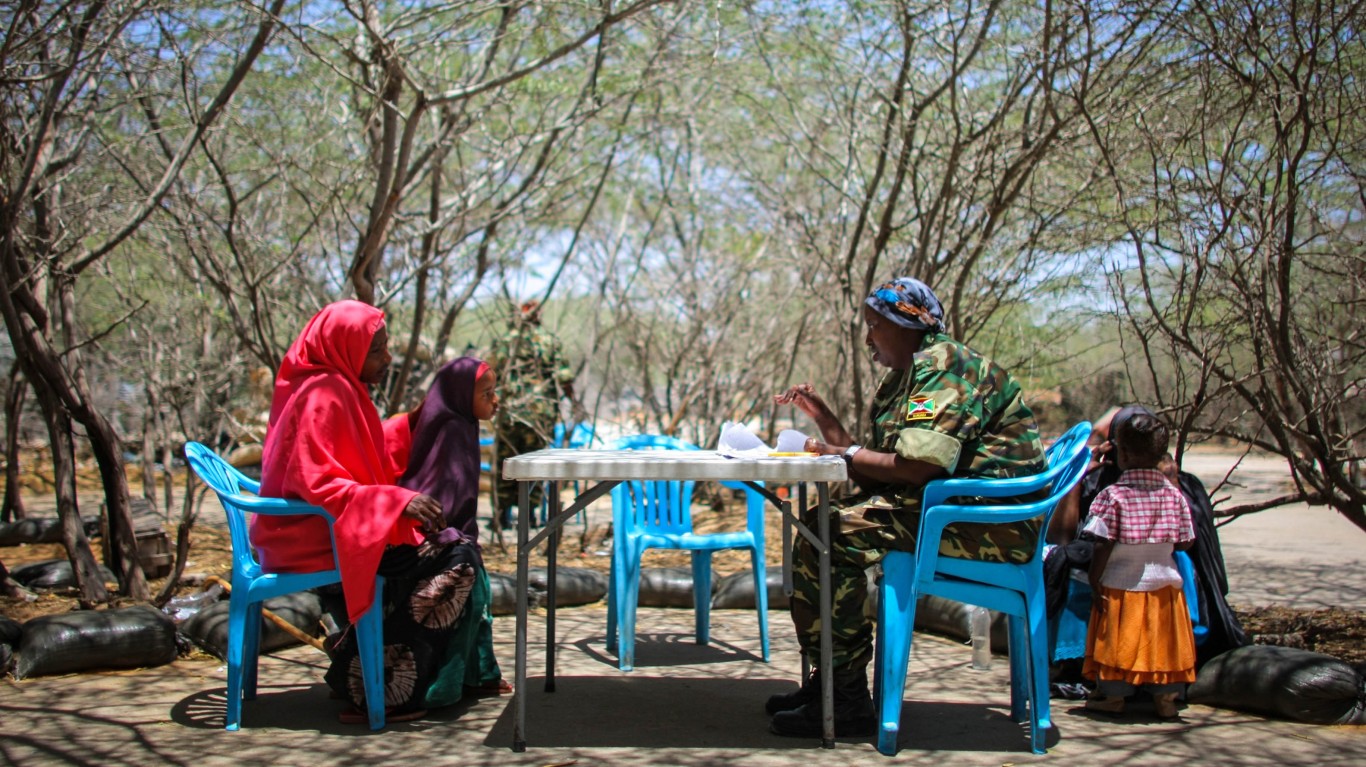
12. Somalia
> Women Peace and Security Index (0 worst to 1 best): 0.572
> Women’s mean years of education: 4.3, #31 worst of 170 countries
> Pct. of women w/bank account: 33.7%, #48 worst of 170 countries
> Absence of legal discrimination (0 worst to 100 best): 47.0 – #14 worst of 170 countries
> GDP per capita, 2021: $447, #5 lowest of 170 countries
> Population, 2021: 17,065,581 (females: 8,509,953, 49.9%)
The organization U.N. Women reported that virtually all Somali girls and women age 15-49 have been subjected to female genital mutilation. The 2021 WPS Index estimates that only about one in five Somali women are employed, while about the same percentage report having been abused by an intimate partner. In 2020, Somalia’s parliament sparked outrage for replacing legislation to protect women and children from violence with a bill permitting child and forced marriages.
[in-text-ad-2]

11. Palestine
> Women Peace and Security Index (0 worst to 1 best): 0.571
> Women’s mean years of education: 9.4, #90 worst of 170 countries
> Pct. of women w/bank account: 16.0%, #13 worst of 170 countries
> Absence of legal discrimination (0 worst to 100 best): 26.3 – #1 worst of 170 countries
> GDP per capita, 2021: $3,664, #63 lowest of 170 countries
> Population, 2021: 5,483,450 (females: 2,697,221, 49.2%)
While Palestine remains under “Israeli military occupation and discriminatory rule” that constitutes apartheid, per Amnesty International, the human rights group also points to internal corruption and discrimination in the West Bank and Gaza Strip. In 2021, “women enjoyed fewer rights than men in relation to divorce, custody of children and inheritance, and violence against women increased. Relatives attacked women who refused to give up their inheritance or sued for other rights relating to personal status, with inadequate protection from the authorities.” Indeed, Palestine ranks as the worst country in terms of legal discrimination against women in the WPS index.

10. Sierra Leone
> Women Peace and Security Index (0 worst to 1 best): 0.563
> Women’s mean years of education: 2.9, #12 worst of 170 countries
> Pct. of women w/bank account: 15.4%, #11 worst of 170 countries
> Absence of legal discrimination (0 worst to 100 best): 69.4 – #43 worst of 170 countries
> GDP per capita, 2021: $480, #7 lowest of 170 countries
> Population, 2021: 8,420,641 (females: 4,201,801, 49.9%)
Along with other West African countries, Sierra Leone has one of the highest rates of female genital mutilation in the world. UNICEF estimated in 2021 that 86% of Sierra Leonean women aged 15-49 have undergone FGM, and that nearly 30% of women aged 20-24 were married or betrothed before they turned 18. The 2021 WPS Index estimates that only 45% of women in Sierra Leone use a cell phone and that one in five reported being a target of intimate partner violence. On a more optimistic note, in January, Sierra Leone passed the Gender Equality and Women’s Empowerment Act, which reserves 30% of public and private sector jobs to women and equal access to banking services.
[in-text-ad]
9. Sudan
> Women Peace and Security Index (0 worst to 1 best): 0.556
> Women’s mean years of education: 3.3, #15 worst of 170 countries
> Pct. of women w/bank account: 10.0%, #8 worst of 170 countries
> Absence of legal discrimination (0 worst to 100 best): 29.4 – #4 worst of 170 countries
> GDP per capita, 2021: $752, #17 lowest of 170 countries
> Population, 2021: 45,657,202 (females: 22,842,482, 50.0%)
The nonprofit International Service for Human Rights says that since Sudan’s military coup on Oct. 25, 2021, violence against girls and women has increased. “Women farmers in conflict areas are facing intensifying violence that includes killing, injuries and rape in armed militia’s attacks while farming or fetching water and wood,” the group added. The U.N. Population Fund estimates that 2.7 million women and girls in Sudan need violence protection, mitigation, and response services. Only 25% of Sudanese women are employed, and only 10% have a bank account.
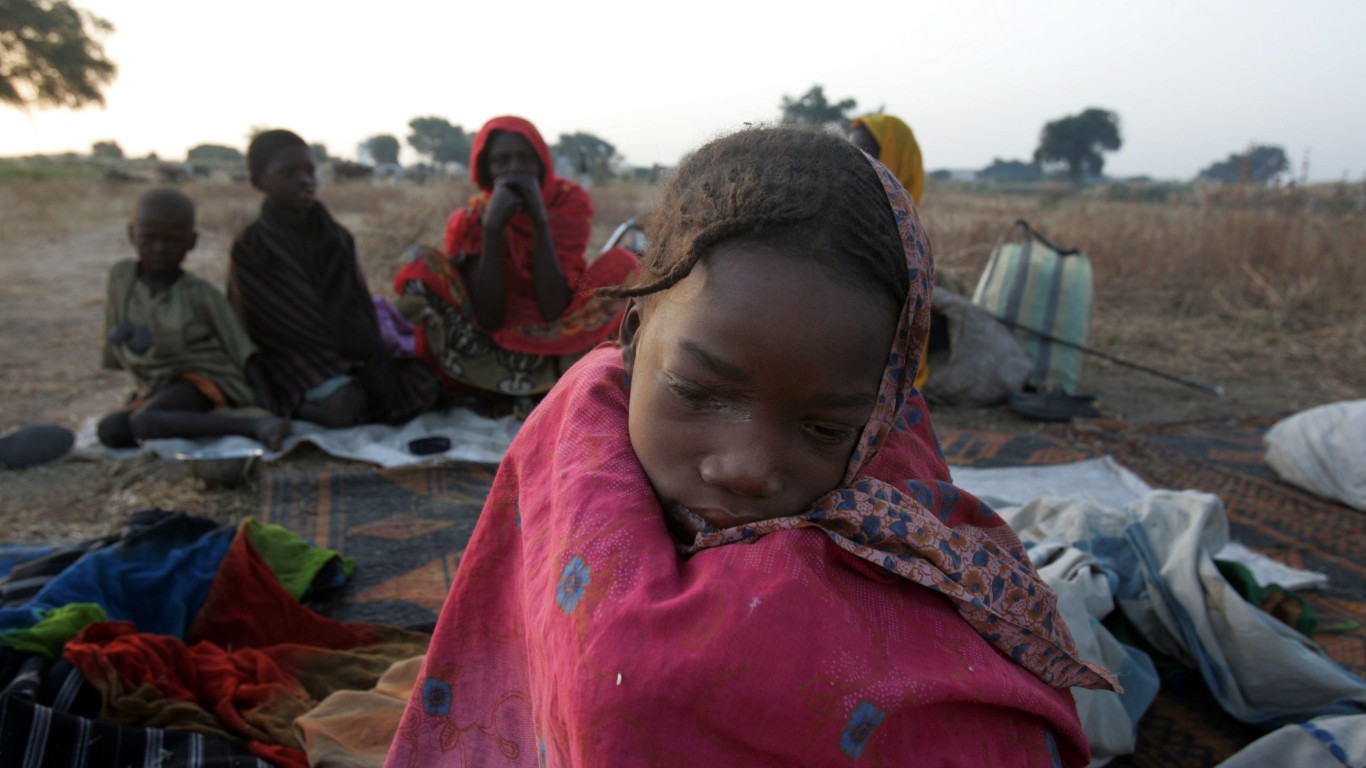
8. Chad
> Women Peace and Security Index (0 worst to 1 best): 0.547
> Women’s mean years of education: 1.3, #2 worst of 170 countries
> Pct. of women w/bank account: 14.9%, #10 worst of 170 countries
> Absence of legal discrimination (0 worst to 100 best): 66.3 – #38 worst of 170 countries
> GDP per capita, 2021: $686, #15 lowest of 170 countries
> Population, 2021: 17,179,740 (females: 8,556,210, 49.8%)
Nearly 61% of women in Chad aged 20-24 were married before they turned 18, while only about 18% of Chadian women had access to modern family planning methods, according to U.N. Women. Women in this north-central African country have among the world’s lowest rates of education, spending an average of just 1.3 years in school. The 2021 WPS Index says Chadian women also have among the world’s lowest rates of cell phone use at just 37%.

7. Democratic Republic of the Congo
> Women Peace and Security Index (0 worst to 1 best): 0.547
> Women’s mean years of education: 5.3, #40 worst of 170 countries
> Pct. of women w/bank account: 24.2%, #23 worst of 170 countries
> Absence of legal discrimination (0 worst to 100 best): 78.8 – #76 worst of 170 countries
> GDP per capita, 2021: $577, #11 lowest of 170 countries
> Population, 2021: 95,894,118 (females: 48,319,268, 50.4%)
The D.R.C. is among the world’s poorest countries with about 70% of the country’s 96 million people living below the poverty threshold as defined by the U.N. Human Development Index. Intimate partner violence continues to be an issue, largely due to societal instability. “A recent study from Democratic Republic of the Congo found that both former and current displacement significantly worsened women’s risk of intimate partner violence in the past year, as well as other forms of gender-based violence such as rape,” the 2021 WPS Index noted. On a brighter note, the share of women with cell phone access has increased as did women’s parliamentary representation.
[in-text-ad-2]

6. South Sudan
> Women Peace and Security Index (0 worst to 1 best): 0.541
> Women’s mean years of education: 3.9, #22 worst of 170 countries
> Pct. of women w/bank account: 4.7%, #2 worst of 170 countries
> Absence of legal discrimination (0 worst to 100 best): 70.0 – #45 worst of 170 countries
> GDP per capita, 2015: $1,072, #26 lowest of 170 countries
> Population, 2021: 10,748,272 (females: 5,427,688, 50.5%)
A March 2022 report from the U.N. Commission describes a “hellish existence for women and girls” in the world’s latest internationally recognized country. All armed groups in the country are perpetuating widespread rape as sexual violence is being treated as a reward to men participating in armed conflict. More than one in four women in South Sudan report having been targets of sexual violence from an intimate partner, and about three out of four women in the country have no access to a cell phone.
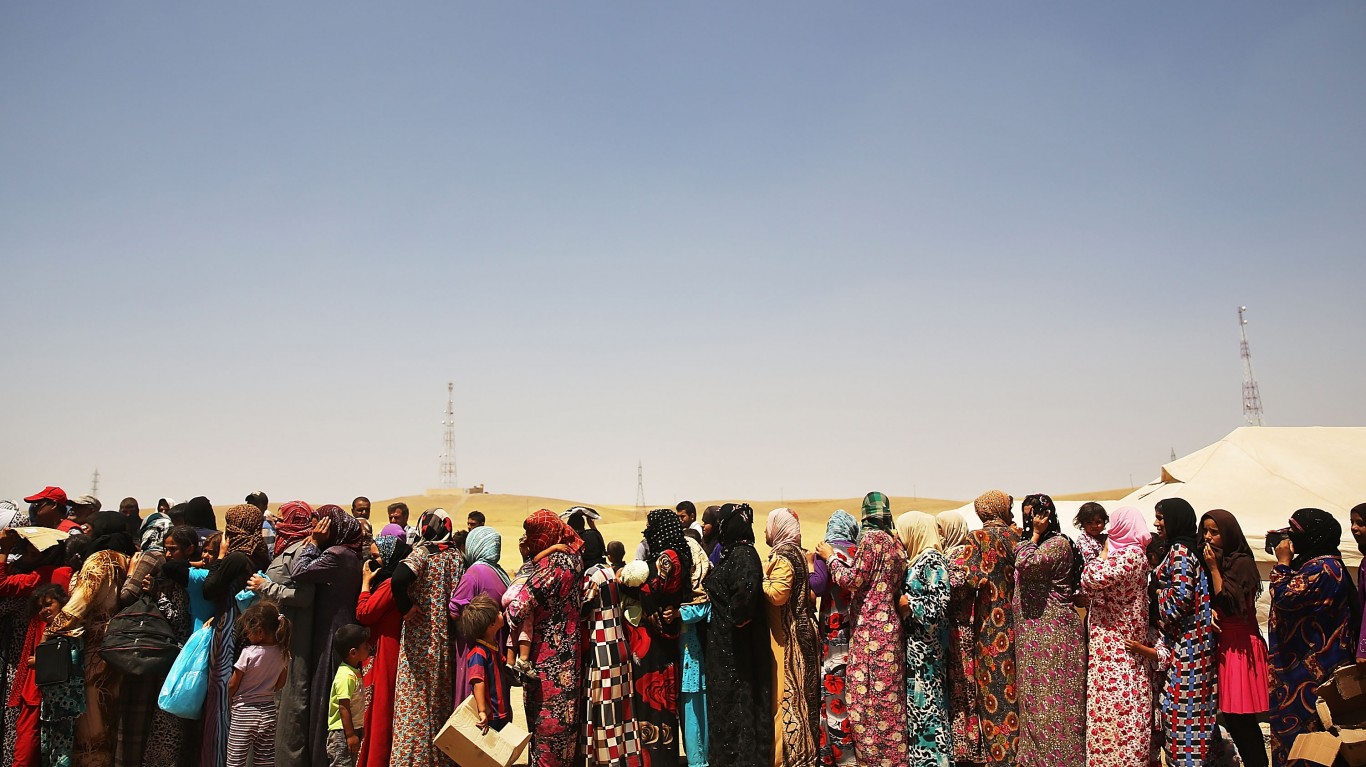
5. Iraq
> Women Peace and Security Index (0 worst to 1 best): 0.516
> Women’s mean years of education: 6.0, #46 worst of 170 countries
> Pct. of women w/bank account: 19.5%, #17 worst of 170 countries
> Absence of legal discrimination (0 worst to 100 best): 45.0 – #10 worst of 170 countries
> GDP per capita, 2021: $4,775, #79 lowest of 170 countries
> Population, 2021: 43,533,592 (females: 21,736,184, 49.9%)
At 45%, Iraq has the highest rate of violence against women perpetuated by an intimate partner, according to the 2021 WPS Index. While only one in 10 Iraqi women are employed, nearly all of them use cell phones, an unusually high share among countries with comparable rates of development. Among laws that discriminate against women in Iraq is one identified by the London School of Economics and Political Science that codifies the husband’s right to punish the wife if the punishment — domestic violence in many cases — was committed “with honorable motives.”
[in-text-ad]

4. Pakistan
> Women Peace and Security Index (0 worst to 1 best): 0.476
> Women’s mean years of education: 3.9, #22 worst of 170 countries
> Pct. of women w/bank account: 7.0%, #4 worst of 170 countries
> Absence of legal discrimination (0 worst to 100 best): 55.6 – #22 worst of 170 countries
> GDP per capita, 2021: $1,505, #35 lowest of 170 countries
> Population, 2021: 231,402,117 (females: 114,586,264, 49.5%)
Pakistan once again scores poorly on the WPS Index, behind Iraq and South Sudan. The number of years of girls’ and women’s education and rates of paid employment has declined since 2017. Though Pakistan has made significant strides in poverty reduction in the past 20 years, there are increasingly stark economic disparities within the country. In other words, the situation for women in Balochistan, the country’s poorest province, is much worse than in Punjab, the country’s wealthiest province.
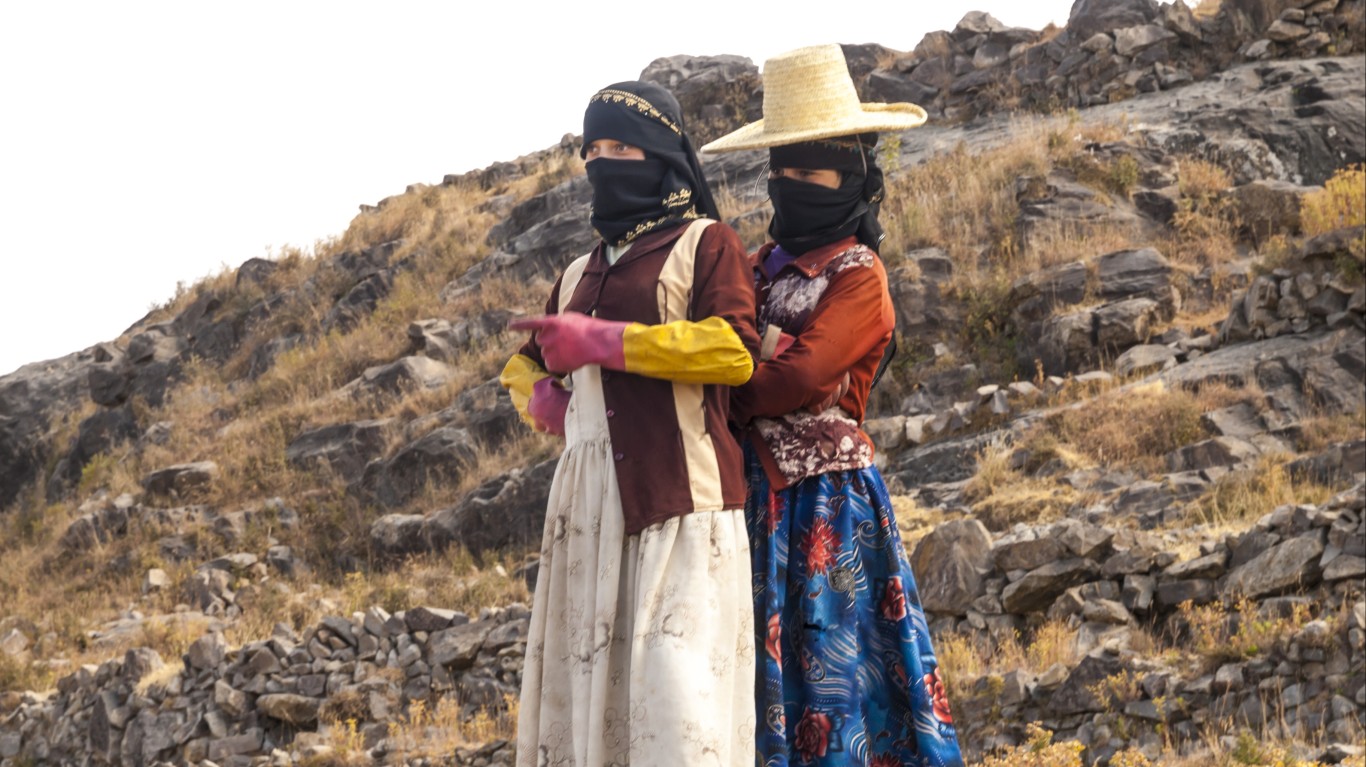
3. Yemen
> Women Peace and Security Index (0 worst to 1 best): 0.388
> Women’s mean years of education: 2.9, #12 worst of 170 countries
> Pct. of women w/bank account: 1.7%, #1 worst of 170 countries
> Absence of legal discrimination (0 worst to 100 best): 26.9 – #2 worst of 170 countries
> GDP per capita, 2018: $702, #16 lowest of 170 countries
> Population, 2021: 32,981,641 (females: 16,313,210, 49.5%)
“Politically, Yemeni women do not exist, as they are completely absent from the decision-making process,” said Bilkis Abouosba, head of the Awam Foundation for Development and Culture and Yemeni women’s rights activist, in a 2022 interview. She pointed out that since the eruption of Yemen’s civil war in 2015, women have been pushed out of political bodies they had served in before the war. Indeed, the 2021 WPS Index shows Yemen has the lowest rate of women’s parliamentary representation, at just 1%. Meanwhile, less than 2% of Yemeni women have bank accounts, and only 5% have paid employment.
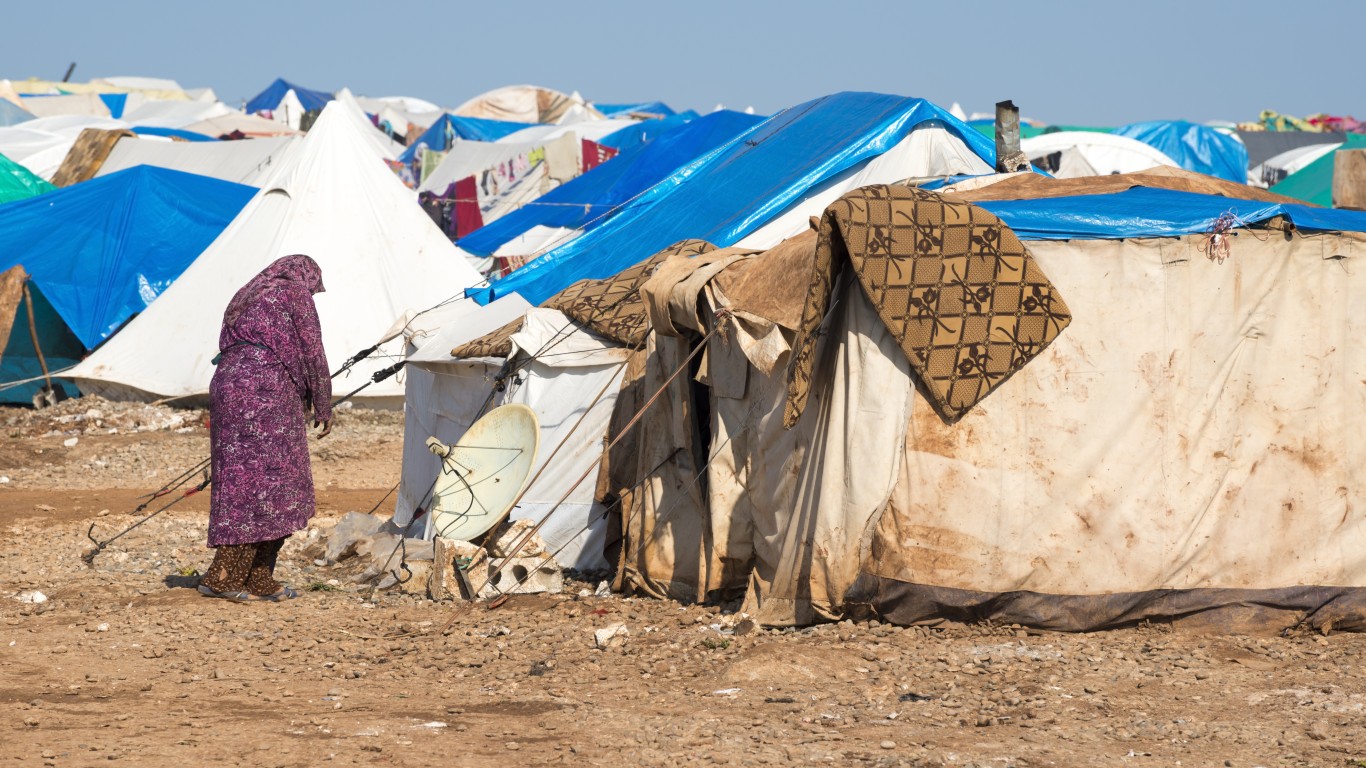
2. Syria
> Women Peace and Security Index (0 worst to 1 best): 0.375
> Women’s mean years of education: 4.6, #34 worst of 170 countries
> Pct. of women w/bank account: 19.6%, #18 worst of 170 countries
> Absence of legal discrimination (0 worst to 100 best): 36.9 – #8 worst of 170 countries
> GDP per capita, 2020: $533, #10 lowest of 170 countries
> Population, 2021: 21,324,367 (females: 10,643,230, 49.9%)
Since Syria’s descent into a multi-sided civil war in 2011, conditions for Syrian women inside the country have eroded. Extremist groups have imposed strict interpretations of Islamic law (Shariah) on women and girls in areas they control that undermine freedoms that women and girls previously enjoyed, “which were a longtime strength of Syrian society,” said Liesl Gerntholtz, women’s rights director at Human Rights Watch in 2014. Thanks to its ongoing conflicts, Syria also ranks high in conflict-related sexual violence and low in women’s inclusion, justice, and security. Only 14% of Syrian women have paid employment.
[in-text-ad-2]

1. Afghanistan
> Women Peace and Security Index (0 worst to 1 best): 0.278
> Women’s mean years of education: 1.9, #6 worst of 170 countries
> Pct. of women w/bank account: 7.2%, #5 worst of 170 countries
> Absence of legal discrimination (0 worst to 100 best): 38.1 – #9 worst of 170 countries
> GDP per capita, 2021: $369, #4 lowest of 170 countries
> Population, 2021: 40,099,462 (females: 19,844,584, 49.5%)
As this list illustrates, countries mired in armed conflict tend to rank low in the rights of women and girls. Since the Taliban returned to power following the complete withdrawal of U.S. and allied forces from Afghanistan in August 2021, the misogyny that typifies these radical fundamentalists has also returned in force. The Taliban not only reconstituted its notorious morality police (the Ministry for the Propagation of Virtue and the Prevention of Vice), it also instituted a ban on women in amusement parks, reinitiated travel restrictions for women, forced women back into face-covering burqas, and banned women and girls from education beyond the sixth grade.
Methodology
To find the 25 worst countries for women, 24/7 Wall St. reviewed the Women, Peace, and Security Index 2021/22 published by Georgetown Institute for Women, Peace and Security and Peace Research Institute Oslo. 2021. Countries are ranked by their index score between 0 and 1, where scores closer to 0 denote countries that are worse for women, and scores closer to 1 scores are better for women. The index ranks 170 countries using 11 indicators.
The 11 indicators include: mean years of education for women ages 25+; the percentage of women ages 15+ who have a bank (or similar) account, alone or jointly; the percentage of the female population ages 25+ that is employed; the percentage of women ages 15+ who report having a cell phone; the percentage of parliamentary seats held by women; the absence of legal discrimination indicator – the degree (0 to 100) to which the laws and regulations differentiate between women and men; son bias using sex ratio at birth; the percentage of males ages 15+ who do not think it is acceptable for a woman to have paid jobs outside their home; the percentage of females ages 15+ who feel safe walking alone at night; the percentage of women who experienced physical or sexual violence by an intimate partner; the total number of battle deaths from state and non-state conflicts per 100,000 people. Full methodology can be found in the full report.
Population figures and gross domestic product per capita in current U.S. dollars are from the World Bank. We used population figures to break ties.
Get Ready To Retire (Sponsored)
Start by taking a quick retirement quiz from SmartAsset that will match you with up to 3 financial advisors that serve your area and beyond in 5 minutes, or less.
Each advisor has been vetted by SmartAsset and is held to a fiduciary standard to act in your best interests.
Here’s how it works:
1. Answer SmartAsset advisor match quiz
2. Review your pre-screened matches at your leisure. Check out the advisors’ profiles.
3. Speak with advisors at no cost to you. Have an introductory call on the phone or introduction in person and choose whom to work with in the future
Thank you for reading! Have some feedback for us?
Contact the 24/7 Wall St. editorial team.



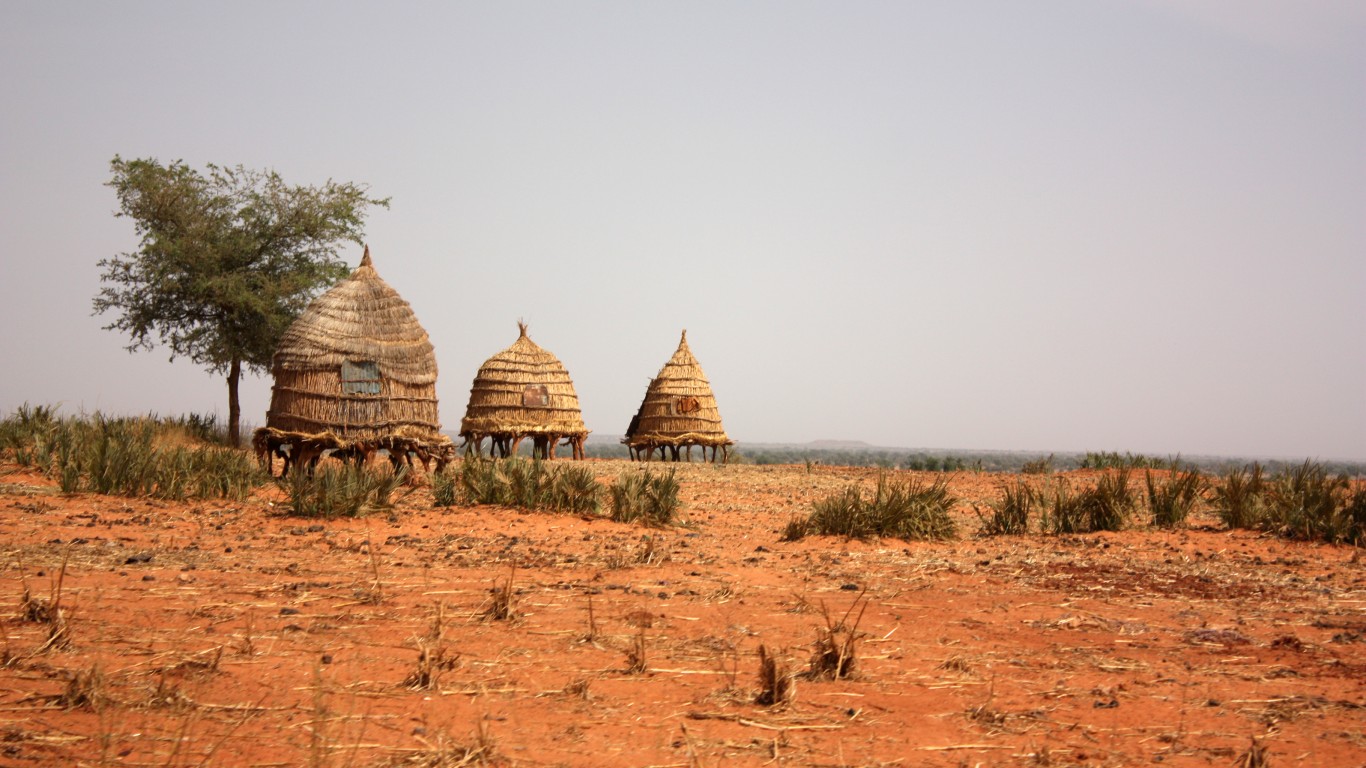 24/7 Wall St.
24/7 Wall St.
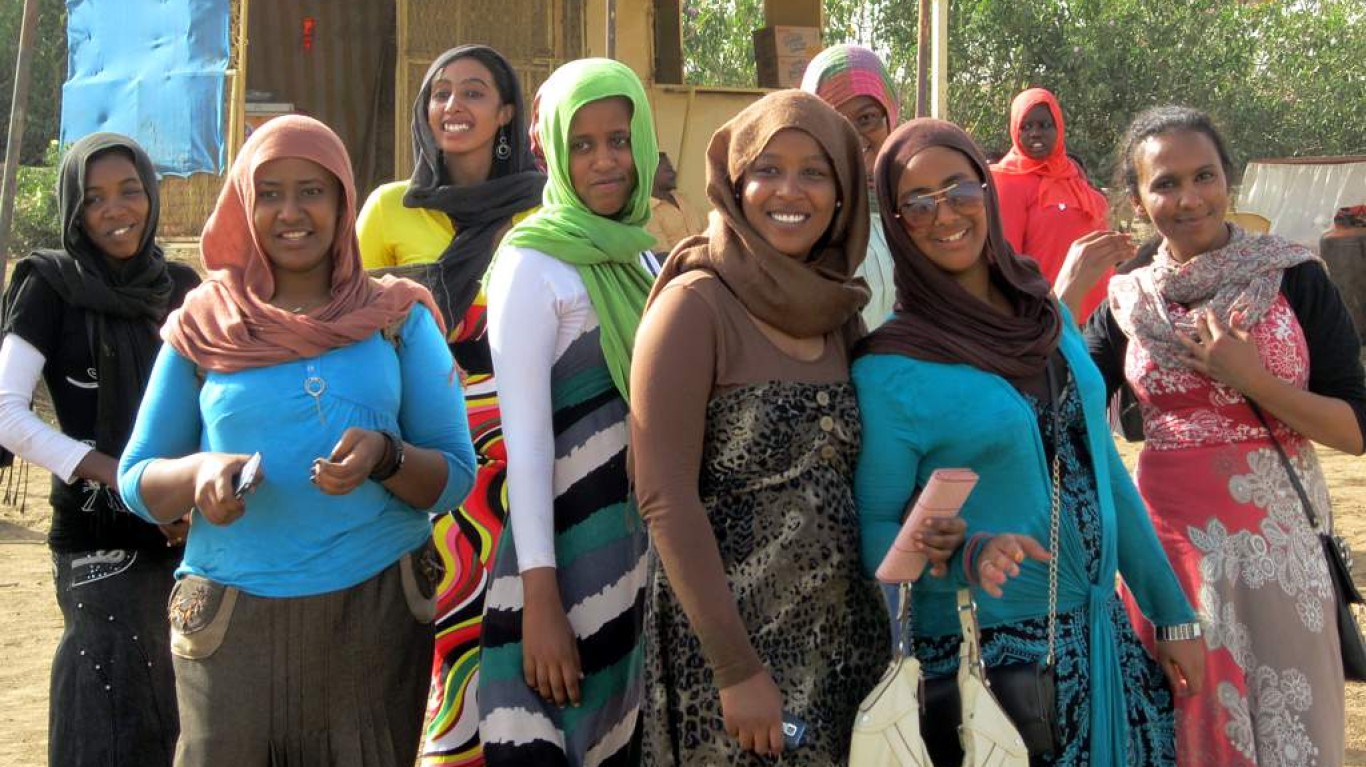
 24/7 Wall St.
24/7 Wall St. 24/7 Wall St.
24/7 Wall St.